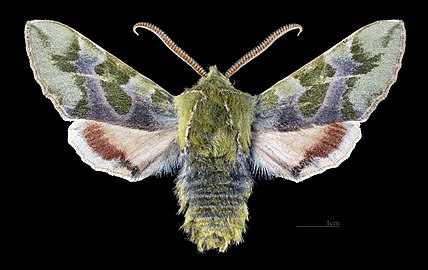| Pacific green sphinx | |
|---|---|

| |
| Live adult attracted to a UV light | |
| Scientific classification | |
| Domain: | Eukaryota |
| Kingdom: | Animalia |
| Phylum: | Arthropoda |
| Class: | Insecta |
| Order: | Lepidoptera |
| Family: | Sphingidae |
| Genus: | Proserpinus |
| Species: | P. lucidus |
| Binomial name | |
| Proserpinus lucidus (Boisduval, 1852) | |
| Synonyms | |
| |
Proserpinus lucidus, the Pacific green sphinx or bear sphinx, is a moth of the family Sphingidae first described by Jean Baptiste Boisduval in 1852.
Distribution
It lives on the Pacific coast of the United States in Washington, Idaho, Oregon and California.
Description
The green forewings are 22–23 mm long, with pink/purple transverse bands outlined in yellow.
Biology
Adults fly in one generation in winter, from December to April, during which they do not eat. They are attracted to lights, but normally females will remain stationary and emit a pheromone to attract males.
The larvae feed on Clarkia breweri and Clarkia modesta and probably Clarkia purpurea, Camissonia bistorta and Camissonia strigulosa. In later instars they lose the horn that characterizes most sphinx moth caterpillars, and instead have a "bullseye" spot. The caterpillars can reach 5 cm.
The caterpillars begin to pupate four to five weeks after hatching. They will pupate under leaf litter or burrow up to 16.5 cm down into the root mass of their host plants, and wait until next winter to eclose (emerge).
References
- Boisduval, J.-A. (25 February 1852). "Lepidoptères de la Californie". Annales de la Société Entomologique de France. 10 (2): 319.
- "CATE Creating a Taxonomic eScience - Sphingidae". Cate-sphingidae.org. Archived from the original on 2012-11-05. Retrieved 2011-10-25.
- ^ Powell, Jerry A.; Opler, Paul A. (2009). Moths of Western North America (1 ed.). Berkeley: University of California Press. p. 245. ISBN 978-0-520-25197-7.
- "890195.00 – 7872 – Proserpinus lucidus – Bear Sphinx Moth – (Boisduval, 1852)". North American Moth Photographers Group. Mississippi State University. Retrieved December 7, 2018.
- ^ Tony-2 (January 31, 2018). "Species Proserpinus lucidus - Pacific Green Sphinx Moth - Hodges#7872". BugGuide. Retrieved December 7, 2018.
{{cite web}}: CS1 maint: numeric names: authors list (link) - ^ Rubinoff, D. (2001). "Observations of adult and larval behavior in the winter sphingid, Arctonotus lucidus (Sphingidae)". Journal of the Lepidopterists' Society. 55 (2): 78–79. Retrieved 2 March 2018.
- Osborne, Kendall H. (22 June 2000). "Additional notes of Proserpinus clarkiae and Arctonotus lucidus (Sphingidae) life histories from the Pacific Coast of North America". Journal of the Lepidopterists' Society. 53 (4): 170–172.
External links
- Lotts, Kelly & Naberhaus, Thomas (2017). "Pacific green sphinx Proserpinus lucidus Boisduval, 1852". Butterflies and Moths of North America. Retrieved December 7, 2018.
- "Arctonotus lucidus Boisduval, 1852". Sphingidae of the Americas. Archived June 12, 2007.
| Taxon identifiers | |
|---|---|
| Arctonotus lucidus | |
This Macroglossini-related article is a stub. You can help Misplaced Pages by expanding it. |

